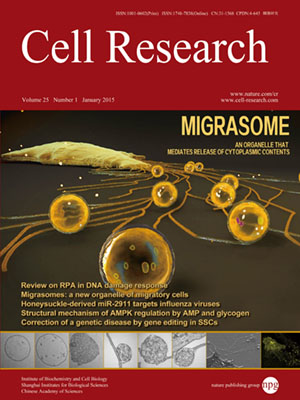
Volume 25, No 1, Jan 2015
ISSN: 1001-0602
EISSN: 1748-7838 2018
impact factor 17.848*
(Clarivate Analytics, 2019)
Volume 25 Issue 1, January 2015: 24-38 | Open Access
ORIGINAL ARTICLES
Discovery of the migrasome, an organelle mediates release of cytoplasmic contents during cell migration
Liang Ma1,*, Ying Li1,*, Junya Peng1,*, Danni Wu1, Xiaoxin Zhao1, Yitong Cui1, Lilian Chen1, Xiaojun Yan2, Yanan Du2,3 and Li Yu1
1State Key Laboratory of Biomembrane and Membrane Biotechnology, Tsinghua University-Peking University Joint Center for Life Sciences, School of Life Science, Beijing 100084, China
2Department of Biomedical Engineering, School of Medicine, Tsinghua University, Beijing 100084, China
3Collaborative Innovation Center for Diagnosis and Treatment of Infectious Diseases, Hangzhou, Zhejiang 310003, China
Correspondence: Li Yu,(liyulab@mail.tsinghua.edu.cn)
Cells communicate with each other through secreting and releasing proteins and vesicles. Many cells can migrate. In this study, we report the discovery of migracytosis, a cell migration-dependent mechanism for releasing cellular contents, and migrasomes, the vesicular structures that mediate migracytosis. As migrating cells move, they leave long tubular strands, called retraction fibers, behind them. Large vesicles, which contain numerous smaller vesicles, grow on the tips and intersections of retraction fibers. These fibers, which connect the vesicles with the main cell body, eventually break, and the vesicles are released into the extracellular space or directly taken up by surrounding cells. Since the formation of these vesicles is migration-dependent, we named them “migrasomes”. We also found that cytosolic contents can be transported into migrasomes and released from the cell through migrasomes. We named this migration-dependent release mechanism “migracytosis”.
10.1038/cr.2014.135
FULL TEXT | PDF
Browse 3229


